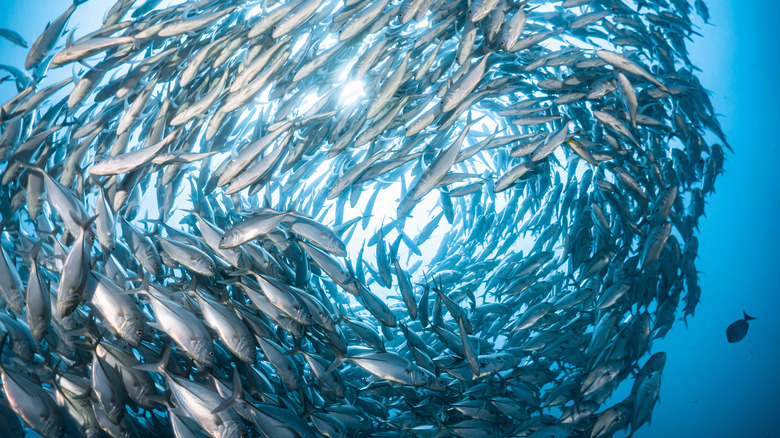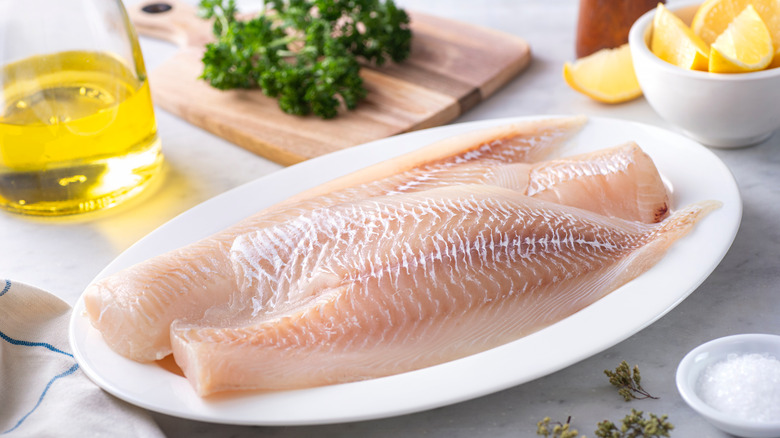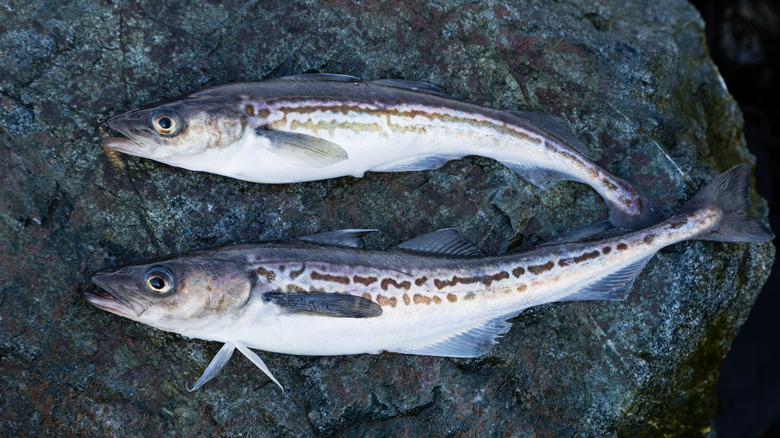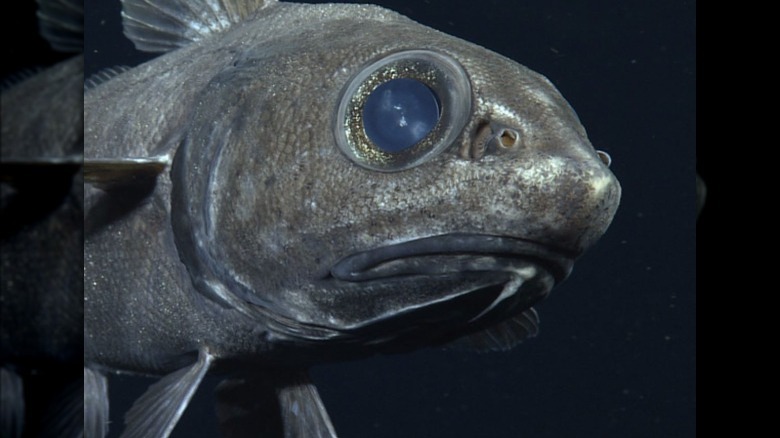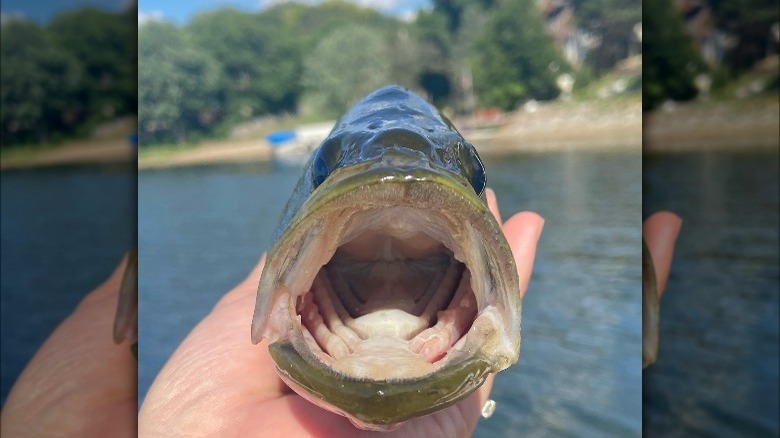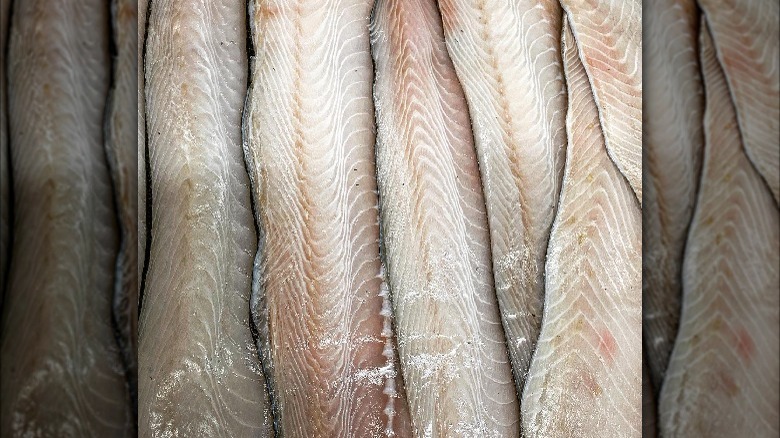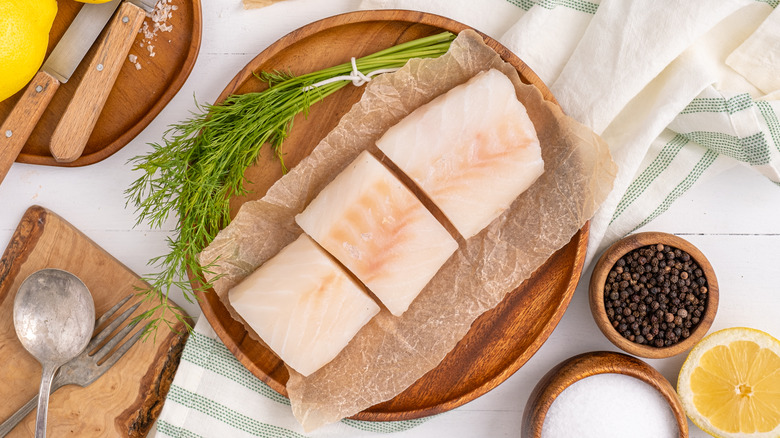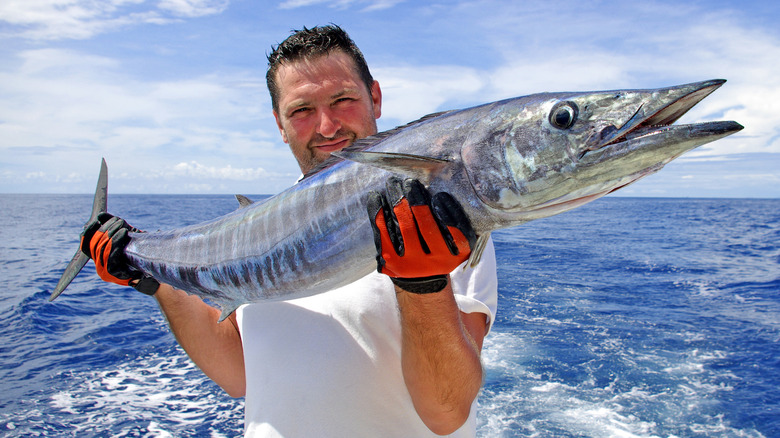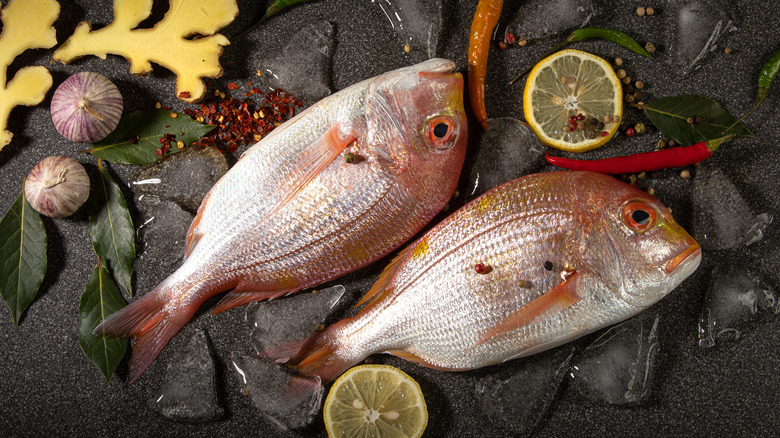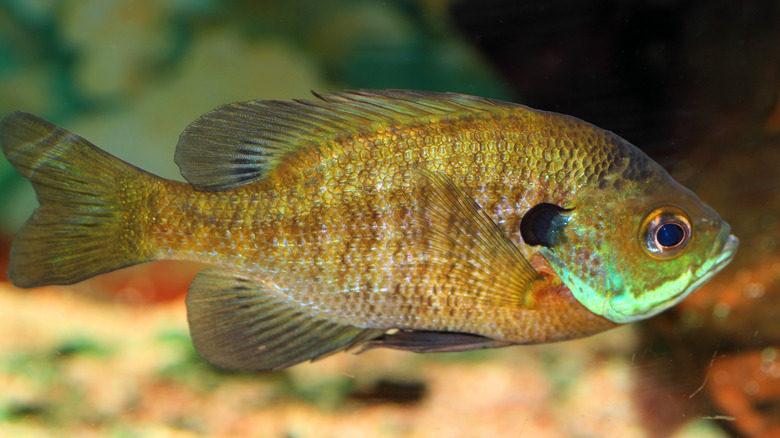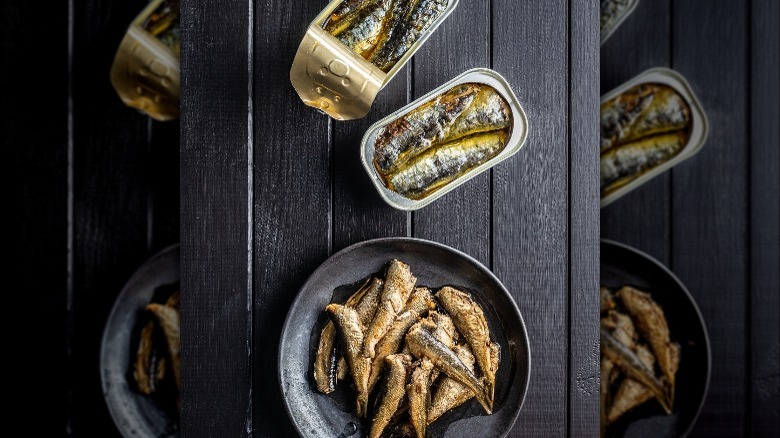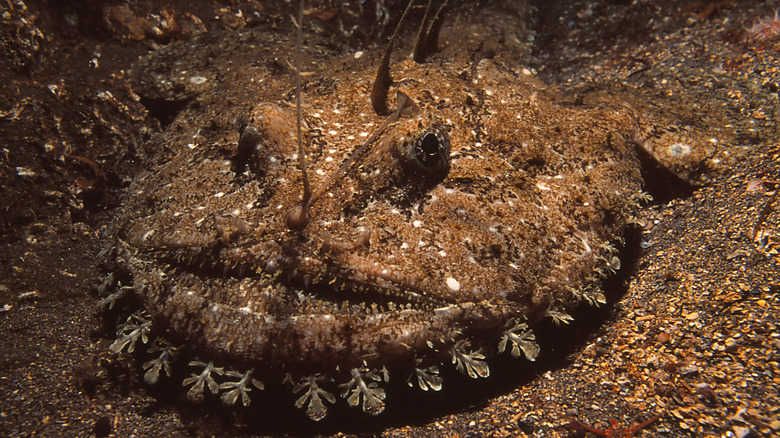11 Types Of Fish And How To Cook Them
It is no secret that fish is well-loved. It has long occupied a spot both in the nutritional pyramid and in our hearts. This is for good reason, per Woman's Health Magazine, which notes that seafood is a very healthful addition to the diet that provides protein and loads of vitamins and minerals that may otherwise be hard to come by.
Of course, it's a brave new world that we're living in and as times (and the climate) change, there looms the big question of how we eat mindfully for ourselves and the environment. Thankfully, there are ways to adjust, and organizations like Save Our Seas are the perfect place to confront such questions. The real first step is simply becoming informed on what's being caught where, and how ethically it's being harvested.
Unfamiliarity with fish and how to best prepare it tends to keep people away. Sure, it's intimidating for newcomers: There are bones, eyes, and at times, scales to work around. But, for those who are willing to learn about where their fish is coming from and how to bring out the best in it once it makes it to the table, a fish-leaning diet is smooth sailing. We decided to explain the basics of how to use 11 varieties of sustainable fish so you can buy and cook them with confidence.
1. Haddock
Haddock is a relative of cod that is celebrated for all the things that tend to characterize white fish: firm flesh, moist texture, and a mild flavor that lends itself well to many styles of cooking (via Marine Stewardship Council). Haddock has long occupied the same spaces that the insanely popular cod fish has: in English suppers, soups, and notably fish and chips.
For white fish fanatics, however, haddock might be the more ethical swap-in for cod, which is currently under extreme threat from years of unethical past mismanagement (via NOAA). Haddock, on the other hand, especially if it's wild-caught from the North Sea and Iceland, is currently rated as one of the Marine Stewardship Council's "best choices" for sustainable fish.
An easy swap-in to offer some respite for a long-challenged fish species — it seems like a no-brainer, right? But, do keep in mind when cooking with haddock, it will be sweeter, if only slightly, than cod. When cooking haddock at home, this white fish is pretty forgiving. A baked white haddock, for example, can be whipped up in 20 minutes and made with ingredients that are probably already floating around the kitchen. Lemon, butter, and olive oil add zing to the otherwise mild fish and make for a light, yet nourishing meal.
2. Alaska pollock
Another white fish, pollock might be best known for its starring role in fish sticks. But wild Alaska pollock has many more uses than just being formed into fingers and dipped in ketchup. In the era of the fast food fish sandwich, the mild and wild Alaska pollock seems to have found yet another place to call home (via Genuine Alaska Pollock Producers). The producers credit its widespread use in Lent-time sandwiches to the fish's availability, sustainable harvests, and nutritional value. Though of course, you should always take claims of any fast food being nutritionally worthwhile with a grain of salt.
If pollock is anything, it is palatable. This is evident from its continued presence as a darling of the fried fish world. Chef's Resources describes pollock's taste as delicate and minimally oily. Compared to other giants of the white fish world, like haddock and cod, pollock is slightly milder. For more sustainable pollock, make sure to seek out wild-caught varieties from the Aleutian Islands or the Gulf of Alaska, not the West Bering Sea, where stocks are currently below optimal levels, according to the Marine Conservation Society. A more inventive use for pollock is as imitation crabmeat. When prepared at home, imitation crab can make for a cost-effective, filling, and delicious crab rangoon.
3. California grenadier
Ain't it grand? Or rather, ain't it grenadier? The California grenadier is a sleek grey fish with an extremely long tail that has earned it the less than appetizing nickname rattail (via Real Good Fish). Historically grenadiers were a by-catch, or unintentional catch, that happened while in pursuit of more sought-after varieties. Nowadays, it still isn't the most desirable catch, the grenadier is starting to gain traction, especially in its home state of California (via Sea Grant California).
There are certainly many uses for this fish once caught, and it feels like a shame to even refer to these fish as waste just because they haven't been historically valued. Oftentimes, according to both sources, this fish has been fried or whipped into imitation crab meat. But, really it can do fine on its own. This cheap fish has specifically proved to be a healthful (and inexpensive) addition to school cafeterias in California. While this fish fries up really well, it can be just as yummy served up grilled in a fish taco. The cherry on the top is that the California grenadier stock is well-managed and considered a sustainable alternative to more threatened varieties of fish.
4. Walleye
The interior of the United States may not feel like the place for good fish, but never estimate freshwater fare. Walleye fish call the Great Lakes, Missouri and Mississippi rivers, and Canada home (via National Wildlife Federation). Appropriately, they've become good eats for this massive region and a beloved game fish. So beloved, in fact, that the Wildlife Federation notes that the fish has become the unofficial fish of Ohio.
The walleye is a lean fish that is, per Chef's Resources, mild and slightly sweet in flavor. The site even notes that the walleye is considered by many to be the best-tasting freshwater fish. The site warns that when selecting a walleye, you should judge it more based on how lustrous it skin is than by how clear its eyes are. Walleye fish have cloudy eyes naturally, and thus, the skin is a better sign of how fresh the fish is.
Once selected, the walleye can be cooked up in any number of ways. Some, like Minnesotans, prefer a fried walleye sandwich that pairs the fish with some lettuce, onion, and sesame buns (via Quick Country). Chef's Resources recommends the philosophy of less is more with this delicate fish. It advises to not pair it with any flavors or sauces that may compromise its subtle, yet phenomenal, flavor. As one final tip, the site also warns to not overcook walleye, as the fish has a tendency to take on an unpleasant rubbery flavor when cooked for too long.
5. Sablefish (black cod)
According to Real Good Fish, sablefish is the species that boats are going after when they happen to catch California grenadier. Thankfully, both fish are wonderful choices to put on the plate. Also known as black cod, though it has no relation to actual cod, sablefish is prized for its high oil content, rich flavor, and amazingly rich mouthfeel (via Chef's Resources). This is probably where the fish's third nickname, butterfish, comes from. That's a whole lot of labels for one fish.
Nonetheless, sablefish is undeniably itself. Don't let its rich flavor intimidate you — this fish takes well to additions. Sitka Salmon Shares observes that sablefish does especially well with citrus-based sauces like chimichurri or even with a salad and summer vinaigrette. When grilling sablefish, the website suggests using a little bit of oil and pressure to get the fish's skin mouthwateringly crispy.
If you're cooking and suddenly everything goes south, i.e. the belly of the fish disintegrates, fear not. It's not you, it's them, literally. Sitka Salmon Shares mentions that about 1 in 100 sablefish have a genetic condition called jelly belly, which causes their meat to break down under heat. In that case, some fishmongers will be more than happy to refund you or give you new fish.
6. Pacific cod
Pacific cod is yet another sustainable alternative to Atlantic cod. As implied by the name, Pacific cod is native to the Pacific Ocean and has long been a staple for the many peoples who have lived in this region (via Chef's Resources and Thought Co.). Simply put, Pacific cod is an important food source that has nourished generations of people. Nowadays, it remains important, and it's sustainably harvested, according to the Marine Conservation Society.
Like other cod, Pacific cod has a mild flavor, lean flesh, and flakiness that makes it especially yummy, according to Chef's Resources. Unlike other cod, however, Pacific cod typically gives you a thicker filet that doesn't hold up as well to breading and battering as say, haddock (via Chef's Resources). While Global Seafoods suggests giving a Pacific cod fish and chips a try, it also does note that the meaty filet makes for a wonderful baked fish or protein-rich addition to a creamy soup. In the long run, the latter two may both be better and healthier options than fried cod. Further adding to the appeal is that meaty Pacific cod is not only filling — it's enriching. It contains the protein and omega-3 fatty acids found in most fish as well as vitamin A and D in its liver oil. Pacific cod is an all-around sturdy choice.
7. Wahoo (ono)
The wahoo fish is native to the seas surrounding Hawaii, and legend goes that the name originates from a European misspelling of Oahu (via Seafood Source). The Hawaiian word for this fish, ono, literally means delicious or good to eat, according to both Seafood Source and Chef's Resources. This is more than understandable given the fish's mild to sweet flavor and flaky flesh (via Chef's Resources). Seafood Source observes that when grilled, wahoo can taste similar to both chicken and veal.
The wahoo fish is a part of the mackerel family and is considered a good alternative to the more endangered king mackerel. Though do be wary: Like many large fish, wahoo does contain elevated levels of mercury. When opting to indulge in the delicious fish, there are a few things to keep in mind. Chef's Resources warns that the wahoo doesn't have a long shelf-life and can only stay fresh for 10 days max.
So, as soon as the fish is purchased, get ready to cook. Seafood Source has some tips to bring out the best in this large fish. The wahoo fish has very little fat, which means that it should be marinated and tenderized not only to keep the flesh moist but also to bring out the high notes of the fish's milder flavor. Wahoo also responds well to smoking, which can add extra complexity to the already yummy fish.
8. Red sea bream
The red sea bream is quite beautiful with its circular shape and bright red coloring. It has long been valued in Southeast Asia, but especially in Japan where it has been enjoyed for as long as anyone can remember (via Taste of Japan). According to the site, its bright red body is considered lucky, and red sea bream can be found at numerous Japanese festivals and ceremonies where it is eaten from head to tail.
Despite its bold and bright skin, the red sea bream is still a white fish with a relatively mild flavor. Samuel's Seafood also describes the fish as average, in a good way: It has a medium oil content, flakiness, and texture. This profile has landed the red sea bream in many different dishes. Taste of Japan notes that in Japan, red sea bream can be found in clear soups, tempura, or served as sashimi. But red sea bream can also be fried, poached, or served in dishes as variable as carpaccio, ceviche, bouillabaisse, and paella (via Taste of Japan and Samuel's Seafood). Suffice it to say that this fish really does find a home wherever it goes. Given its popularity in so many different cuisines, this fish is certainly being pulled in many directions. The Aquaculture Stewardship Council Foundation notes that aquaculture farms based in the Mediterranean are heavily regulated and can provide sustainable, delicious red sea bream.
9. Bluegill bream
Another member of the bream family, the bluegill bream, known affectionately to some fishers as freshwater sunfish, is native to the rivers of the East Coast and some areas of Northeastern Mexico (via Take Me Fishing). That being said, the bluegill has been introduced to other environments both intentionally and unintentionally and now can be found around the world.
A favorite among fly fishers, the bluegill bream can also make a splash in the kitchen. Panfish Nation describes the fish as a wonderful combination of mild flavor and firm texture and confirms that many believe the bluegill bream to be the tastiest of the sunfish family. It doesn't matter if you're at the campfire or on the stove top, the website says to just make sure that the bluegill is either fried or cooked whole. It's simply the best way to enjoy this tiny fish. Of course, being a panfish website, the site sticks by the idea that the most proper way to enjoy a bluegill sunbeam is by pan-frying it. That's down-home cooking. If caught during summer, female bluegills will often have eggs that can be enjoyed on their own as a rich delicacy.
10. Canned sardines
Sardines are familiar friends that only get better the more you get to know them. During the first wave of the pandemic, as people all over the world scrambled to approach food in a radically different way, sardines saw a resurgence. An article in The New York Times addressed questions of how to properly use sardines and assured that they could be a wonderful addition to the diet, whether in the depths of a world-altering crisis or not. The article observes that canned sardines really hit a perfect balance of durable, nutritious, and delicious. Sardines are even a sustainable food choice when sourced from sardine stocks off the coast of Africa and in the Southern Celtic Sea (via the Marine Conservation Society).
There's a world of tinned sardines out there and countless varieties of canned sardines, but there are certain things that ring true for every brand. Sardines are defined by their meaty texture and intense flavor and they are almost always sold headless, but with spines and bones still in place. When choosing sardines, they will either be packaged in water or oil, as noted by The New York Times. Sardines can make for a filling snack when paired with crackers and a good mustard. Sardines can also add nuance to an otherwise bland tuna salad. Ultimately, it comes down to personal preference, which can of sardines you bring home with you, and how you prefer to use them.
11. Monkfish
Sure, the monkfish may look like the stuff of nightmares, but what's old adage about judging books by their covers? With nicknames like the sea devil, it seems like the world has rushed too soon to judge the poor monkfish, which is also more flatteringly known as the poor man's lobster.
This homely fish not only has a rich flavor, but a distinct aroma and an amazingly meaty, lobster-like texture. Talk about a triple threat! The monkfish is a bigger fish, and unlike other white fish, it doesn't have small bones to work around when cooking. The fish's tails, cheeks, and liver are delicacies that taste even richer than the rest of the meat on this decadent fish.
While it's possible to eat this species raw or cooked, cooked monkfish is the superior choice. For pescatarians, the monkfish can work as a wonderful alternative to turkey and goose during the holiday season and can similarly be stuffed. While found internationally, the most sustainable monkfish for those in the U.S. is most likely monkfish that's been caught stateside. NOAA notes that monkfish stocks at the time being are not threatened by overfishing and are currently well managed. This means that the seafood world's yummiest open secret is not only a delicious choice, but a smart one too.
